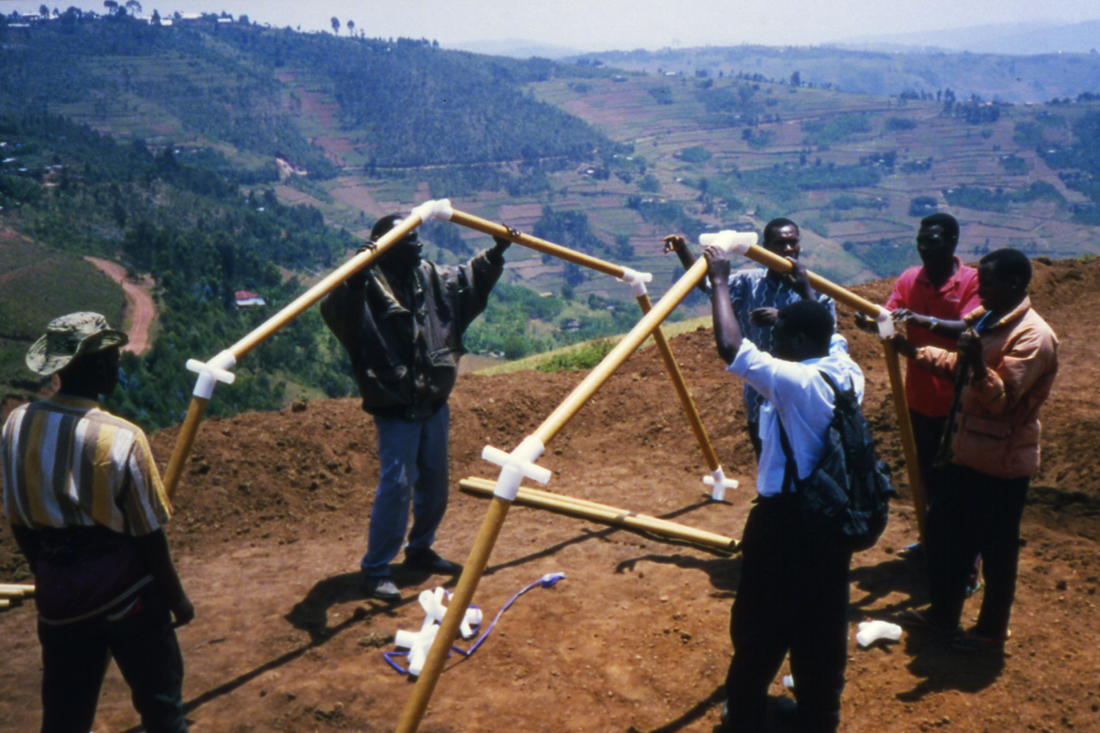| Location | Rwanda |
| Date | 1998 |
| Client | UNHCR |
| End client | Rwandan refugees |
| Design firm | Shigeru Ban Architects |
| Funding | UNHCR |
In 1994 Rwanda’s civil war displaced more than two million people.
Following protocol, the UNHCR sent the standard supply of plastic sheeting and aluminum poles to be used as temporary shelters, but the agency failed to foresee the local value of the aluminum. Refugees sold the poles and then cut down trees for structural supports instead, thus contributing to an already pressing deforestation crisis.
Just as the UNHCR was grappling with this problem, the Japanese architect Shigeru Ban, known for his sculptural arbors and galleries made from paper tubes, approached the agency with a proposal to construct emergency shelter using the same material. Commissioned by the United Nations, Ban developed a frame of paper tubes and plastic connectors that could transform standard plastic sheeting into tents. The tubes had no monetary value, thereby ensuring they would be used for shelter. With support from Vitra, Ban designed three prototype shelters, and in 1998 he worked with refugees and relief agencies to build 50 emergency shelters in Rwanda. Ultimately, however, the frame proved too costly and difficult to replicate, according to the UNHCR.



In Rwanda, frames for shelters were assembled from paper tubes and plastic connectors. Shigeru Ban
In the meantime the Great Hanshin Earthquake of 1995, the largest quake to hit Japan since 1923, gave Ban the opportunity to channel his ideas toward humanitarian work closer to home. Striking just six months after Ban first met with UN officials, the earthquake caused unprecedented damage to the city of Kobe. Many of the city’s poorest neighborhoods were hardest hit. Temporary housing for displaced families was built on the outskirts of Kobe, but tent camps persisted because many people had jobs in the city center. Working with university students Ban built 21 temporary homes from paper tubes and plastic beer crates donated by Kirin. (Crates by Sapporo, Shigeru often jokes, did not suit the design.) Each home took volunteer and student workers six hours to construct. Indigenous and sustainable, the homes enabled families to remain near their jobs while waiting for permanent housing. His Paper Log House design was adapted for Turkey and India after earthquakes in 1999 and 2001, respectively. But once again the process proved too cumbersome to replicate on a large scale
Amid the confusion Ban also built a small church in Kobe where a Catholic cathedral had been destroyed by fires resulting from the earthquake. Of all his work this humble, elliptical gathering space would prove to be the most meaningful and lasting. Earthquake survivors used the Takatori Paper Church for meetings, and the building became a symbol of the reconstruction, offering an oasis of healing in a time and place where little comfort could be found. Construction of the church was completed in five weeks by 160 volunteers. Ten years after the disaster the church was finally removed to make way for a new cathedral. Plans were made to reconstruct it in Taomi, Taiwan, which had recently been hard hit by an earthquake.
















READ OR LEAVE A COMMENT